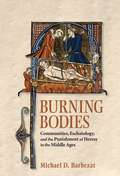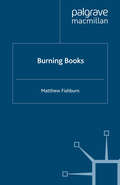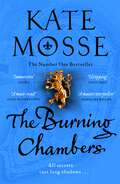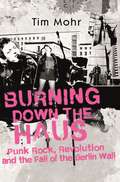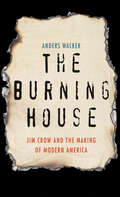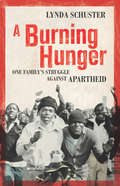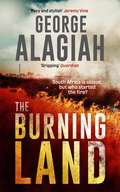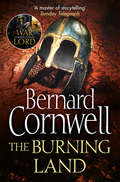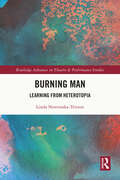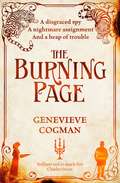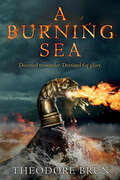- Table View
- List View
Burned Bridge: How East and West Germans Made the Iron Curtain
by Edith ShefferThe building of the Berlin Wall in 1961 shocked the world. Ever since, the image of this impenetrable barrier between East and West, imposed by communism, has been a central symbol of the Cold War. Based on vast research in untapped archival, oral, and private sources, Burned Bridge reveals the hidden origins of the Iron Curtain, presenting it in a startling new light. Historian Edith Sheffer's unprecedented, in-depth account focuses on Burned Bridge-the intersection between two sister cities, Sonneberg and Neustadt bei Coburg, Germany's largest divided population outside Berlin. Sheffer demonstrates that as Soviet and American forces occupied each city after the Second World War, townspeople who historically had much in common quickly formed opposing interests and identities. The border walled off irreconcilable realities: the differences of freedom and captivity, rich and poor, peace and bloodshed, and past and present. Sheffer describes how smuggling, kidnapping, rape, and killing in the early postwar years led citizens to demand greater border control on both sides--long before East Germany fortified its 1,393 kilometer border with West Germany. It was in fact the American military that built the first barriers at Burned Bridge, which preceded East Germany's borderland crackdown by many years. Indeed, Sheffer shows that the physical border between East and West was not simply imposed by Cold War superpowers, but was in some part an improvised outgrowth of an anxious postwar society. Ultimately, a wall of the mind shaped the wall on the ground. East and West Germans became part of, and helped perpetuate, the barriers that divided them. From the end of World War II through two decades of reunification, Sheffer traces divisions at Burned Bridge with sharp insight and compassion, presenting a stunning portrait of the Cold War on a human scale.
Burned Bridge: How East and West Germans Made the Iron Curtain
by Edith ShefferThe building of the Berlin Wall in 1961 shocked the world. Ever since, the image of this impenetrable barrier between East and West, imposed by communism, has been a central symbol of the Cold War. Based on vast research in untapped archival, oral, and private sources, Burned Bridge reveals the hidden origins of the Iron Curtain, presenting it in a startling new light. Historian Edith Sheffer's unprecedented, in-depth account focuses on Burned Bridge-the intersection between two sister cities, Sonneberg and Neustadt bei Coburg, Germany's largest divided population outside Berlin. Sheffer demonstrates that as Soviet and American forces occupied each city after the Second World War, townspeople who historically had much in common quickly formed opposing interests and identities. The border walled off irreconcilable realities: the differences of freedom and captivity, rich and poor, peace and bloodshed, and past and present. Sheffer describes how smuggling, kidnapping, rape, and killing in the early postwar years led citizens to demand greater border control on both sides--long before East Germany fortified its 1,393 kilometer border with West Germany. It was in fact the American military that built the first barriers at Burned Bridge, which preceded East Germany's borderland crackdown by many years. Indeed, Sheffer shows that the physical border between East and West was not simply imposed by Cold War superpowers, but was in some part an improvised outgrowth of an anxious postwar society. Ultimately, a wall of the mind shaped the wall on the ground. East and West Germans became part of, and helped perpetuate, the barriers that divided them. From the end of World War II through two decades of reunification, Sheffer traces divisions at Burned Bridge with sharp insight and compassion, presenting a stunning portrait of the Cold War on a human scale.
The Burned-over District: The Social and Intellectual History of Enthusiastic Religion in Western New York, 1800–1850
by Whitney R. CrossDuring the first half of the nineteenth century the wooded hills and the valleys of western New York State were swept by fires of the spirit. The fervent religiosity of the region caused historians to call it the "burned-over district."
The Burning Blue: A New History of the Battle of Britain
by Jeremy A. Crang Paul AddisonIt was, of course, the Battle of Britain, or rather its conclusion, that prompted one of Winston Churchill's most memorable pieces of oratory that has its epitome in the sentence, 'Never in the field of human conflict was so much owed by so many to so few.' If the Battle of Britain had been lost it is very likely the New Order to which the Axis powers had pledged themselves would have become global with unthinkable consequences for the world afterwards.The importance of the Battle of Britain cannot be exaggerated though inevitably in the succeeding years the accretion of myth has brought about many distortions. This multi-faceted symposium emerged from the Centre of Second World War Studies at Edinburgh University with the aim, in the words of the editors, 'to reassess established themes while opening up new ones.' After a masterly introduction by Brian Bond, the book is divided into six parts: Before the Battle; The Battle; The View from Afar; Experience and Memory; The Making of a British Legend and The Significance. The contributors are: Klaus A. Maier; Malcolm Smith; Horst Boog; Sebastian Cox; Sergei Kudryshov; Richard P. Hallion; Theodore F. Cook; Hans-Ekkehard Bob; Wallace Cunningham; Nigel Rose; Owen Dudley Edwards; Angus Calder; Tony Aldgate; Adrian Gregory; Jeremy Lake and John Schofield; Paul Addison and Jeremy A. Crang and Richard Overy. No survey could be more wide-ranging or fascinating. First published in 2000 to mark the 60th anniversary, it is now being reissued in 2010 to mark the 70th anniversary.'But it is terrific. It's not only an acknowledgement of the heroism of the fighter pilots (and all the ancillary crew), but a serious contribution to the historical record. Seventeen contributors write about the Battle from pretty much every conceivable angle; and Addison and Crang have chosen them well. . . This is not an automatically worshipful book; it poses questions about the morality of war, the existence of heroism, the reliability of memory. But it treats the subject honestly and with justice. And it tells us why we won: because, it would appear, it helps to come from a society that is sceptical of authority rather than in blind, unthinking terror of it.' Nicholas Lezard, Guardian''This book is a first-class piece of work, stimulating, informative and concise.' Brian Holden Reid, Times Higher Education Supplement.'This is a nugget of a book . . . it assembles, most readably, a range of authoritative and international views on the Battle, its history, and its significance.' Air Chief Marshall Sir Michael Graydon, Royal United Services Institute'This is a much told story, but the varied viewpoints of the 20 contributors to Burning Blue - ranging from a fascinating essay by Owen Dudley Edwards on the air war as reflected in children's literaturer to the memories of pilots who fought in it on both sides - give an impressive breadth and depth. And even though it strips away hindsight and refuses to burnish legends, what is left is still one of the most remarkable stories in the whole of British history. The British empire didn't last a thousand years, but the man was right: this truly was its finest hour.' David Robinson, The Scotsman
The Burning Blue
by James HollandJoss Lambert has always been a loner, constrained by a secret from his past, until he finds friendship and solace firstly with Guy Liddell, a friend from school, and then with Guy's family, who welcome him into their farmhouse home. Joss increasingly comes to depend upon the Liddells and treats Alvesdon Farm as the one place where he feels not only appreciated but also truly happy. But in late 1930s England, the idyll cannot last. With war looming, Joss is forced to confront the past. He escapes through flying, becoming a fighter pilot in the RAF. But with the onset of war, even the Liddells' world is crumbling. As Joss is fighting for his life in the Battle of Britain, so he begins to fall madly in love with Stella - Guy's twin - but with tragic consequences. Leaving England and the Liddells far behind, he continues to fly amid the sand and heat of North Africa's deserts, flying above the 'Desert Rats' of the 8th Army, until his hopes and dreams are seemingly shattered for good...
Burning Bodies: Communities, Eschatology, and the Punishment of Heresy in the Middle Ages
by Michael D. BarbezatBurning Bodies interrogates the ideas that the authors of historical and theological texts in the medieval West associated with the burning alive of Christian heretics. Michael Barbezat traces these instances from the eleventh century until the advent of the internal crusades of the thirteenth century, depicting the exclusionary fires of hell and judicial execution, the purifying fire of post-mortem purgation, and the unifying fire of God's love that medieval authors used to describe processes of social inclusion and exclusion.Burning Bodies analyses how the accounts of burning heretics alive referenced, affirmed, and elaborated upon wider discourses of community and eschatology. Descriptions of burning supposed heretics alive were profoundly related to ideas of a redemptive Christian community based upon a divine, unifying love, and medieval understandings of what these burnings could have meant to contemporaries cannot be fully appreciated outside of this discourse of communal love. For them, human communities were bodies on fire. Medieval theologians and academics often described the corporate identity of the Christian world as a body joined together by the love of God. This love was like a fire, melting individuals together into one whole. Those who did not spiritually burn with God's love were destined to burn literally in the fires of Hell or Purgatory, and the fires of execution were often described as an earthly extension of these fires. Through this analysis, Barbezat demonstrates how presentations of heresy, and to some extent actual responses to perceived heretics, were shaped by long-standing images of biblical commentary and exegesis. He finds that this imagery is more than a literary curiosity; it is, in fact, a formative historical agent.
Burning Books
by M. FishburnThis provocative new work examines the years between the Nazi book fires and the publication of Ray Bradbury's Fahrenheit 451 (1953), a period when book burning captured the popular imagination. It explores how embedded the myths of book burning have become in our cultural history, and illustrates the enduring appeal of a great cleansing bonfire.
Burning Bright
by Tracy Chevalier‘A visual delight’ The Times ‘A splendidly vital recreation of Georgian London’ Sunday Times
The Burning Chambers: the Sunday Times Number One Bestseller (The Burning Chambers #1)
by Kate Mosse* Sunday Times Number One Bestseller *From the multi-million, number one bestselling author of Labyrinth and The Taxidermists Daughter, comes The Burning Chambers: a gripping story of love and betrayal, mysteries and secrets, conspiracies and divided loyalties . . . Carcassonne 1562. Nineteen-year-old Minou Joubert receives an anonymous letter at her father’s bookshop. Sealed with a distinctive family crest, it contains just five words: SHE KNOWS THAT YOU LIVE. But before Minou can decipher the mysterious message, a chance encounter with a young Huguenot convert, Piet Reydon, changes her destiny forever. For Piet has a dangerous mission of his own, and he will need Minou’s help if he is to get out of La Cité alive . . . A thrilling adventure, and a heart-breaking love story, The Burning Chambers is a historical novel of excitement, conspiracy and danger like no other . . .
Burning Down The Haus: Punk Rock, Revolution and the Fall of the Berlin Wall
by Tim MohrLONGLISTED FOR THE CARNEGIE MEDAL FOR EXCELLENCE'Mohr digs into the subject of East German punk like nobody before' Rolling Stone GermanyTim Mohr brings us the secret history of punks in East Germany. Burning Down the Haus is a reclamation and an exaltation of youth culture and idealism as not only an instigator for discourse, but as an actual catalyst for political upheaval and radical change.It began with a handful of East Berlin teens who heard the Sex Pistols on a British military radio broadcast to troops in West Berlin, and it ended with the collapse of the East German dictatorship. Punk rock was a life-changing discovery: in an authoritarian state where the future was preordained, punk, with its rejection of society and DIY approach to building a new one, planted the seeds for revolution.As these kids began to form bands, they also became more visible, and security forces - including the dreaded secret police, the Stasi - targeted them. They were spied on by friends and family; they were expelled from schools and fired from jobs; they were beaten by police and imprisoned. But instead of conforming, the punks fought back, playing an indispensable role in the underground movement that helped bring down the Berlin Wall.Rollicking, cinematic and thrillingly topical, this secret history brings to life the young men and women who successfully fought authoritarianism three chords at a time. Burning Down the Haus is a fiery testament to the irrepressible spirit of revolution.'Burning Down the Haus is not just an immersion into the punk rock scene of East Berlin, it's the story of the cultural and political battles that have shaped the world we live in today' DW Gibson, author of The Edge Becomes the Center: An Oral History of Gentrification in the Twenty-First Century
The Burning Earth: An Environmental History of the Last 500 Years
by Sunil Amrith'Sunil Amrith has given us the most readable global environmental history yet... a towering achievement and a joy to read' - J. R. McNeill'The Burning Earth is as beautiful as it is indispensable, as breathtaking as it is devastating. It answers questions most of us have been too daft even to ask. It will set you on fire' - Jill Lepore, author of These Truths: A History of the United States'A devastating panorama of human folly, a poetic meditation on how the search for freedom from nature undermined the very conditions for life on earth. Beautifully written, Sunil Amrith’s global and long-term view is crucial to understanding the environmental predicaments we are in, and, perhaps, to restore a distraught world. A must read for anyone concerned with the state of the planet' - Sven Beckert, author of Empire of Cotton'Memorable and mesmerizing. Sunil Amrith has gifted us a page-turner of a book, written with passionate lucidity' - Rob Nixon, author of Slow Violence and the Environmentalism of the PoorIn this paradigm-shifting global history of how humanity has reshaped the planet, and the planet has shaped human history, Sunil Amrith twins the stories of environment and Empire, of genocide and eco-cide, of the expansion of human freedom and its costs. Drawing on an extraordinarily rich diversity of primary sources, he reckons with the ruins of Portuguese silver mining in Peru, British gold mining in South Africa, and oil extraction in Central Asia. He explores the railways and highways that brought humans to new terrains of battle against each other and against nature. Amrith’s account of the ways in which the First and Second World Wars involved the massive mobilization not only of men, but of other natural resources from around the globe, provides an essential new way of understanding war as an irreversible reshaping of the planet. He also reveals the reality of migration as consequence of environmental harm.The imperial, globe-spanning pursuit of profit, joined with new forms of energy and new possibilities of freedom from hunger and discomfort, freedom to move and explore, has brought change to every inch of the Earth. Amrith relates, on the largest canvas, a mind-altering epic – vibrant with stories, characters, and vivid images – in which humanity might find the collective wisdom to save itself.
The Burning God (The Poppy War #3)
by R.F. KuangThe exciting end to The Poppy War trilogy, R.F. Kuang's acclaimed, award-winning epic fantasy that combines the history of 20th-century China with a gripping world of gods and monsters, to devastating, enthralling effect.
Burning Grass
by Cyprian EkwensiIn this groundbreaking novella, Cyprian Ekwensi narrates the spectacular adventures of a nomadic family whose lives are turned upside down when their great leader is cursed by his rival to the throne.When Chief Mai Sunsaye smells the smoke of burning grass, he knows it is time to go. Such is the nomadic life of the Fulani. Yet when Mai Sunsaye's rival, Ardo, curses him with wanderer's disease, it provokes in him a new-found sense of adventure, one which takes him further than he ever could have imagined...Full of love, magic, and fateful happenings, Burning Grass is an unforgettable tale that has captured the imagination of children and adults alike.'A joy to read; his glorious imagination captured ours.' Chimamanda Ngozi Adichie'One of the most prolific African writers of the twentieth century.' Charles R. Larson 'Magical occurrences, mysterious and seductive women, acts of phenomenal heroism, and swift-paced adventure.' Margaret Laurence
The Burning House: Jim Crow and the Making of Modern America
by Anders WalkerA startling and gripping reexamination of the Jim Crow era, as seen through the eyes of some of the most important American writers In this dramatic reexamination of the Jim Crow South, Anders Walker demonstrates that racial segregation fostered not simply terror and violence, but also diversity, one of our most celebrated ideals. He investigates how prominent intellectuals like Robert Penn Warren, James Baldwin, Eudora Welty, Ralph Ellison, Flannery O’Connor, and Zora Neale Hurston found pluralism in Jim Crow, a legal system that created two worlds, each with its own institutions, traditions, even cultures. The intellectuals discussed in this book all agreed that black culture was resilient, creative, and profound, brutally honest in its assessment of American history. By contrast, James Baldwin likened white culture to a “burning house,” a frightening place that endorsed racism and violence to maintain dominance. Why should black Americans exchange their experience for that? Southern whites, meanwhile, saw themselves preserving a rich cultural landscape against the onslaught of mass culture and federal power, a project carried to the highest levels of American law by Supreme Court justice and Virginia native Lewis F. Powell, Jr. Anders Walker shows how a generation of scholars and judges has misinterpreted Powell’s definition of diversity in the landmark case Regents v. Bakke, forgetting its Southern origins and weakening it in the process. By resituating the decision in the context of Southern intellectual history, Walker places diversity on a new footing, independent of affirmative action but also free from the constraints currently placed on it by the Supreme Court. With great clarity and insight, he offers a new lens through which to understand the history of civil rights in the United States.
A Burning Hunger: One Family's Struggle Against Apartheid
by Lynda SchusterOn June 16 1976 the students of Soweto rose up in protest against a new rule that all teaching in African schools had to be done in Afrikaans. They were led by a charismatic young man called Tsietsi Mashinini. Tsietsi was one of the thirteen children of Joseph and Nomkhitha Mashinini, God-fearing, law-abiding citizens who had never been mixed up in politics. His actions on that day set in motion a chain of events that would forever define his family, and that would change all their lives. In A Burning Hunger Lynda Schuster tells the story of this remarkable family and in so doing tells the story of black South Africa in microcosm. For this is a family that embraces just about every facet of the liberation struggle. The eldest of the Mashinini children, Rocks, rose to a high rank in the army of the ANC; for years he directed the freedom fighters who infiltrated South Africa from neighboring countries in order to carry out sabotage. Tsietsi, brilliant, articulate, a natural leader, went underground after June 16 and then into exile. He was implacably opposed to the ANC and became the darling of Vanessa Redgrave, Stokely Carmichael and Miriam Makeba. He died in exile in 1990, just as his comrades were returning to their homeland. Mpho, the fourth son, was the most militant. He was eventually arrested, tortured and tried for treason. He went on to establish one of the most important anti-government organizations of the 1980s, the Soweto Youth Congress. Another brother, Dee, went to Tanzania in order to become a guerrilla, but was refused on the grounds of his youth. He eventually worked for Radio Freedom, the voice of the ANC. Yet another, Tshepiso, bookish, church-going, was torn between his studies and political activism. He eventually went to Oxford to study, and returned to South Africa in 1991, becoming a key figure on the Johannesburg council. If the Mandelas were the generals in the fight for black liberation, the Mashininis were the foot soldiers. It is the story of one black family, ordinary but also extraordinary. It is a story of imprisonment, torture, separation and loss, but also of dignity, courage and strength in the face of appalling adversity. It will become one of the seminal books about the struggle against apartheid.
The Burning Land
by George Alagiah'Gripping' Guardian 'Pacy and stylish . . . what a read' Jeremy Vine ‘It was never meant to be like this. Sabotage, yes. Propaganda, yes. All of that and more – but not this. Not murder.’ South Africa has become a powder keg. Its precious land is being sold off to the highest bidders while the country’s corrupt elite pocket the profits. As the dreams and hopes of its people are threatened, frustration turns to violence. With the shocking murder of one of the country’s bright young hopes, the fuse is well and truly lit. When conflict mediator Lindi returns home to the country of her birth she is reunited with her childhood friend Kagiso. Suddenly the professional becomes deeply personal and they find themselves at the heart of the chaos. They have just days to save themselves and the country they love, even as events are set in motion that no one, least of all they, can control.
The Burning Land: A Novel (The Last Kingdom Series #5)
by Bernard CornwellThe fifth novel in Bernard Cornwell’s epic and bestselling series on the making of England and the fate of his great hero, Uhtred of Bebbanburg. BBC2’s major Autumn 2015 TV show THE LAST KINGDOM is based on the first two books in the series.
Burning Man: Learning from Heterotopia (Routledge Advances in Theatre & Performance Studies)
by Linda Noveroske-TrittenThis book centres on a philosophical analysis of creative acts in the Burning Man Festival and their roles in wider social change. With particular focus on the Ten Principles of Burning Man, Linda Noveroske posits a re-interpretation of common notions of “self” and “other” as they apply to identity, difference, and the ways that these personal impulses ripple outward from changing individuals into changing societies. Such radical re-imagination of ideology can be most powerful when it occurs in spaces of otherness, of heterotopia. This study casts Burning Man as a heterotopia to not only destabilizes what we think we know about visual art, performance, and creative encounters, but also bring these acts into an attitude of immediacy that facilitates previously unimagined behaviour and opens out artistic drive into the unknown. This book would be of value for scholars and practitioners in Performance Studies, Theatre and Dance, Art History, Psychology, Phenomenology, Architecture and Urban Studies.
Burning Man: Learning from Heterotopia (Routledge Advances in Theatre & Performance Studies)
by Linda Noveroske-TrittenThis book centres on a philosophical analysis of creative acts in the Burning Man Festival and their roles in wider social change. With particular focus on the Ten Principles of Burning Man, Linda Noveroske posits a re-interpretation of common notions of “self” and “other” as they apply to identity, difference, and the ways that these personal impulses ripple outward from changing individuals into changing societies. Such radical re-imagination of ideology can be most powerful when it occurs in spaces of otherness, of heterotopia. This study casts Burning Man as a heterotopia to not only destabilizes what we think we know about visual art, performance, and creative encounters, but also bring these acts into an attitude of immediacy that facilitates previously unimagined behaviour and opens out artistic drive into the unknown. This book would be of value for scholars and practitioners in Performance Studies, Theatre and Dance, Art History, Psychology, Phenomenology, Architecture and Urban Studies.
The Burning Page: An Invisible Library Novel (The Invisible Library series #3)
by Genevieve CogmanThe third title in Genevieve Cogman's clever and exciting The Invisible Library series, The Burning Page is an action-packed literary adventure! When it's your job to save the day - where do you start?Librarian spy Irene has standards to maintain, especially while on probation. And absconding from a mission via a besieged building doesn't look good. But when her escape route home goes up in flames, what's a spy to do? However, it seems Gates back to the Library are malfunctioning across dozens of worlds. Worse still, her nemesis Alberich is responsible -and he plans to annihilate the Library itself.Irene and assistant Kai are posted to St Petersburg, to help combat this threat. Here Alberich emerges, as Irene tries to save her friend Vale and foil assassination attempts. Then one incredibly dangerous opportunity to save the Library emerges. Saving herself would be a bonus . . .Irene's adventures feature stolen books, secret agents and forbidden societies - think Doctor Who but with librarian spies!
Burning Questions: Essays and Occasional Pieces 2004–2021
by Margaret Atwood** A 2022 Book to Look Forward To in The Times, i, Financial Times, Guardian, Evening Standard, New Statesman, Cosmopolitan and SheerLuxe **From cultural icon Margaret Atwood comes a brilliant collection of essays -- funny, erudite, endlessly curious, uncannily prescient -- which seek answers to Burning Questions such as: Why do people everywhere, in all cultures, tell stories?How much of yourself can you give away without evaporating?How can we live on our planet? Is it true? And is it fair?What do zombies have to do with authoritarianism?In over fifty pieces Atwood aims her prodigious intellect and impish humour at our world, and reports back to us on what she finds. The roller-coaster period covered in the collection brought an end to the end of history, a financial crash, the rise of Trump and a pandemic. From debt to tech, the climate crisis to freedom; from when to dispense advice to the young (answer: only when asked) to how to define granola, we have no better questioner of the many and varied mysteries of our human universe. 'Brilliant and funny' Joan Didion'She's taken our times and made us wise to them' Ali Smith'Lights a fire from the fears of our age . . . Miraculously balances humor, outrage, and beauty' New York Times Book Review'All over the reading world, the history books are being opened to the next blank page and Atwood's name is written at the top of it' Anne Enright, Guardian'The outstanding novelist of our age' Sunday Times
The Burning Roses: The Morland Dynasty, Book 29 (Morland Dynasty #29)
by Cynthia Harrod-EaglesIn 1915 the first euphoria of the war has worn off, but the nation is more determined than ever to win. When Ned is sent to the Front ahead of his battalion, Jessie, already involved in various charity works, feels the need to do more and becomes an auxiliary nurse. But life on the wards is harder than she expects. Meanwhile, Helen and Jack settle in a home of their own at last, and Helen takes on a surprise war role of her own. And for Violet in London, a chance meeting with talented young artist threatens to destroy her calm and ordered life. With stalemate on the Eastern Front, everything now hangs on the new September offensive on the Western Front, the Battle of Loos. Both Ned and Bertie will be leading their men over the top, leaving the rest of the family to pray for their safe return.
A Burning Sea: The third instalment in Theodore Brun's Viking epic, The Wanderer Chronicles (The Wanderer Chronicles)
by Theodore BrunDoomed to wander. Destined for glory.Erlan Aurvandil has turned his back on the past and his native Northern lands, taking a perilous journey to the greatest city in the world, Byzantium. But as his voyage ends, Erlan is brutally betrayed, captured and enslaved by a powerful Byzantine general.Meanwhile, Lilla Sviggarsdottír, Queen of Svealand, has lost her husband and with him, her kingdom. Leaving her lands and people behind, Lilla journeys east on a new quest: to find Erlan and raise an army mighty enough to defeat her usurper.But when she reaches the great city of Byzantium, she discovers a place in turmoil. A dark tide is rising against the Emperor from within his own court. As the shadows darken and whispers of war begin to strengthen, Erlan's fate becomes intertwined with that of the city. Are they both doomed to fall, or can freedom be won in the blood of battle?
The Burning Shore: How Hitler's U-Boats Brought World War II to America
by Ed OffleyThe untold story of two men-an American pilot and a German U-boat commander-whose clash off the coast of North Carolina brought the horrors of World War II to American shores
The Burning Stone (Crown of Stars #3)
by Kate ElliottKING'S DRAGON and PRINCE OF DOGS began Kate Elliott's enthralling tale of the war-torn kingdoms of Wendar and Varre and the story of Alain's and Liath's quests for truth. Now THE BURNING STONE continues the epic saga. An uncertain and uneasy peace has fallen on the kingdom of Wendar. It seems that the king's favour has fallen upon Prince Sanglant, his bastard son, and that he is to be the chosen heir. But Sanglant is too troubled by the recent past to seek that crown. He needs Liath, the woman who saved him from his terrible captivity, even though such a liaison must incur the wrath of his father. For her part, Liath knows that her future lies with Sanglant. But she has also learned that her mother, presumed to be dead, is in fact still alive and searching for her, to school Liath in the powerful sorcerous arts. And Alain, their friend and ally, is in mortal danger from the curse of Bloodheart, who is reaching out from the grave...




